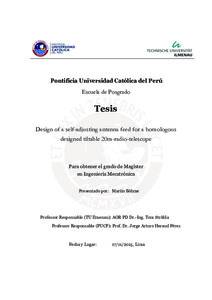Design of a self-adjusting antenna feed for a homologous designed tiltable 20m-radio-telescope
Abstract
Radioteleskope sind verschiedenartigen Umwelteinflüssen ausgesetzt. Dadurch hervorgerufene Verformungen der Reflektoroberfläche verändern deren geometrischen Eigenschaften und können die ursprüngliche Position und Form des Brennpunkts verändern. Eine Abweichung dieses Brennpunkt von der Lage der Primärantenne beeinflusst die Leistungsfähigkeit des Teleskops. Die vorliegende Arbeit zeigt eine Methode zur theoretischen Abschätzung der Verformung durch das Eigengewicht des Reflektors des INRAS RT–20. Jene nach der Idee des homologen Designs von Hoerners konstruierten Teleskopen weisen eine Stützstruktur auf, die die Reflektorfläche unabhängig vom Elevationswinkel in einer der ursprünglichen Form ähnlichen Gestalt halten. Somit kann die Verformung durch das Nachführen der Primärantenne ausgeglichen werden. Grundlage der Untersuchung ist ein vorhandenes Strukturmodell des RT–20–Teleskops. Zusammen mit den zugehörigen Geometriedaten und Materialparameten wird ein Finite-Element-Modell erstellt. Für dieses wird ein Belastungsfall mit dem Eigengewicht für verschiedene Elevationswinkel simuliert. Um die deformierte Reflektorfläche mathematisch zubeschreiben und den passenden Brennpunkt zu bestimmen wird eine parametrisierte Form eines Best-Fit-Paraboloids erörtert. Für die Ermittlung der Parameter werden drei Optimierungsalgorithmen in Matlab ausgeführt und miteinander verglichen. Daraus wird die Verschiebung des Brennpunkts (Defokussierung) ermittelt und der Bedarf einer Korrekturbewegung für die Primärantenne abgeschätzt. In einem Entwurfsprozess werden nach den Ideen der VDI2221–Norm technische Prinzipe für ein Aktuierungssystem entwickelt und bezüglich ausgewählter Kriterien gegeneinander abgewogen. Als Resultat dieses Bewertungsprozesses wird eines der Prinzipe erwählt und spezifiziert. Für die spätere Umsetzung werden Komponenten vorgeschlagen, Bauteile vorbereitend konstruiert und in einer CAD–Software zu einer funktionierenden Baugruppe zusammengefügt. Radio telescopes are exposed to various environmental conditions. These can produce
deformations of the reflector surface that will have impact on its paraboloidal
characteristics determining the position and shape of the focal point. A misalignment
between the reflector focal point and the radiation–receiving primary antenna influences
the performance of the telescope. The actual work presents a method to estimate
theoretically the dead–weight induced deformation of the reflector surface for the INRAS
PUCP RT–20 radio telescope. Such homologous designed telescopes consist of
a backing structure supporting the reflector surface to retain a shape familiar to the
original one and independent of the elevation angle. So it is possible to compensate
the deformation by the adjustment of the primary antenna. The analysis of the deformation
is done for an existing structural model of the RT–20. This model is meshed
with the corresponding geometrical and material properties. In a finite–element software
the load situation due to the telescope’s dead weight is simulated for different
elevation angles. To describe the deformed reflector surface in a mathematical way
an expression for a parametrized best-fitting paraboloid is derived. To determine the
fit-parameters for the discrete point set, three optimization algorithms are executed
in Matlab and their results compared. Based on this, the need of a re-alignment of
the primary antenna is demonstrated. Thereupon a design process for an actuation
system intended for the corrective movement is performed, following the ideas of the
VDI2221–norm. Several mechanical concepts are presented and evaluated in relation
to their suitability for the main needs. Based on this assessment, a parallel–kinematic
mechanism is chosen as the most convenient concept. This is examined in more detail,
including a deviation for the inverse kinematics. For this concept, a preliminary
selection of specific components is done and assembled in a CAD–prototype.
Temas
Radiotelescopios--Diseño y construcción
Radiotelescopios--Sistemas de control
Antenas (Electrónica)
Radiotelescopios--Sistemas de control
Antenas (Electrónica)
Para optar el título de
Maestro en Ingeniería Mecatrónica
Collections
The following license files are associated with this item:






